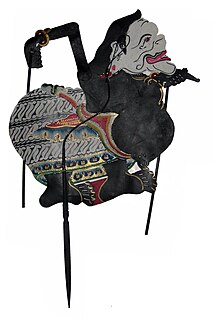 W
WWayang, also known as wajang, is a traditional form of puppet theatre play originated on the Indonesian island of Java. Wayang refers to the entire dramatic show. Sometimes the leather puppet itself is referred to as wayang. Performances of wayang puppet theatre are accompanied by a gamelan orchestra in Java, and by gender wayang in Bali. The dramatic stories depict mythologies, such as episodes from the Hindu epics the Ramayana and the Mahabharata, as well as local adaptations of cultural legends. Traditionally, a wayang is played out in a ritualized midnight-to-dawn show by a dalang, an artist and spiritual leader; people watch the show from both sides of the screen.
 W
WIndra Swara is a group promoting Indonesian art and culture in Mexico. It was created in December 2002 and it is mostly made up of young Mexicans, enthusiasts of Asian arts and particularly those of Indonesia. Some of its members have had the opportunity to study directly in the islands of Java and Bali through the Darmasiswa Scholarship program offered by the Indonesian government.
 W
WThe dhalang or dalang is the puppeteer in an Indonesian wayang performance.
 W
WThe Mahabharata is one of the two major Sanskrit epics of ancient India; it was composed by the sage Vyasa. The most important characters of Mahabharata can be said to include: Krishna; the Pandavas — Yudhishthira, Bheema, Arjuna, Nakula and Sahadeva, along with their wife Draupadi; and the Kauravas, led by the eldest brother, Duryodhana. The most important other characters include Bhishma, Karna, Dronacharya, Shakuni, Dhritrashtra, Gandhari and Kunti. Some pivotal additional characters include Balarama, Subhadra, Vidura, Abhimanyu, Kripacharya, Pandu, Satyavati, Ashwatthama, and Amba. Deities who play a significant role in the epic include Vishnu, Brahma, Shiva, Ganga, Indra, Surya and Yama.
 W
WNgesti Pandawa is a professional wayang wong or wayang orang art company located in Semarang. The Ngesti Pandawa wayang orang is housed in the Ki Narto Sabdho Hall in Taman Budaya Raden Saleh or the Taman Raden Saleh Cultural Complex at Jalan Sriwijaya 29, Semarang City, Central Java Province, Indonesia. Ngesti Pandawa is one of three surviving wayang orang troupes in Indonesia, besides Wayang Orang Sriwedari in Taman Sriwedari Solo and Wayang Orang Bharata in Jakarta. It is hoped that wayang orang will again be able to entertain generations of audiences while sending a timeless moral message.
 W
WPetruk is a character in traditional Javanese puppetry, or wayang. He is one of the Punokawan, four comedic figures common in the medium.
 W
WPrabakusuma in the Javanese wayang is also called by the name Bambang Priyambada. He is the son of Arjuna from his marriage with Princess Dewi Supraba who became his wife when he was the king of kahyangan. Prabukusuma is as handsome and strong as his father. His accuracy in shooting an arrow is quite unbeatable. He was raised by his grandfather, Sage Sidikwaspada from Glagahwangi Monastery. Prabukusuma helped Amarta Kingdom when Princess Mustakaweni stole Jamus Kalimasada by disguising to be Ghatotkacha
 W
WIn Javanese wayang, the panakawan or panakavan (phanakavhan) are the clown servants of the hero. There are four of them – Semar, Petruk, Gareng and Bagong. Semar is the personification of a deity, sometimes said to be the dhanyang or guardian spirit of the island of Java. In Javanese mythology, deities can only manifest themselves as ugly or otherwise unprepossessing humans, and so Semar is always portrayed as short and fat with a pug nose and a dangling hernia.
 W
WSemar is a character in Javanese mythology who frequently appears in wayang shadow plays. He is one of the punokawan (clowns), but is in fact divine and very wise. He is the dhanyang of Java, and is regarded by some as the most sacred figure of the wayang set. He is said to be the god Sang Hyang Ismaya in human form.
 W
WSulukan normally refers to mood setting songs by a puppeteer (dhalang) in Javanese wayang ("puppet") performances in Indonesia. The term can also refer to the pathetan pieces played before and after gamelan pieces in a non-wayang context, and to mystical poetry relating to the doctrinal meaning of the term sulook.
 W
WWayang golek is one of the traditional Sundanese puppet arts from West Java, Indonesia. in contrast to the wayang art on other Javanese islands that use leather in the production of wayang, wayang golek is a wayang art made of wood. Wayang Golek is very popular in West Java, especially in the Pasundan land area. Today, wayang golek has become an important part of Sundanese culture in West Java.
 W
WWayang kulit is a traditional form of puppet-shadow play originally found in the cultures of Java, Bali, and Lombok in Indonesia. In a wayang kulit performance, the puppet figures are rear-projected on a taut linen screen with a coconut-oil light. The dalang manipulates carved leather figures between the lamp and the screen to bring the shadows to life. The narratives of wayang kulit often have to do with the major theme of good vs. evil.
 W
WWayang wong, also known as wayang orang, is a type of classical Javanese and Balinese dance theatrical performance with themes taken from episodes of the Ramayana or Mahabharata. Performances are stylised, reflecting Javanese court culture:Wayang wong dance drama in the central Javanese Kraton of Yogyakarta represents the epitome of Javanese aesthetic unity. It is total theatre involving dance, drama, music, visual arts, language, and literature. A highly cultured sense of formality permeates every aspect of its presentation.